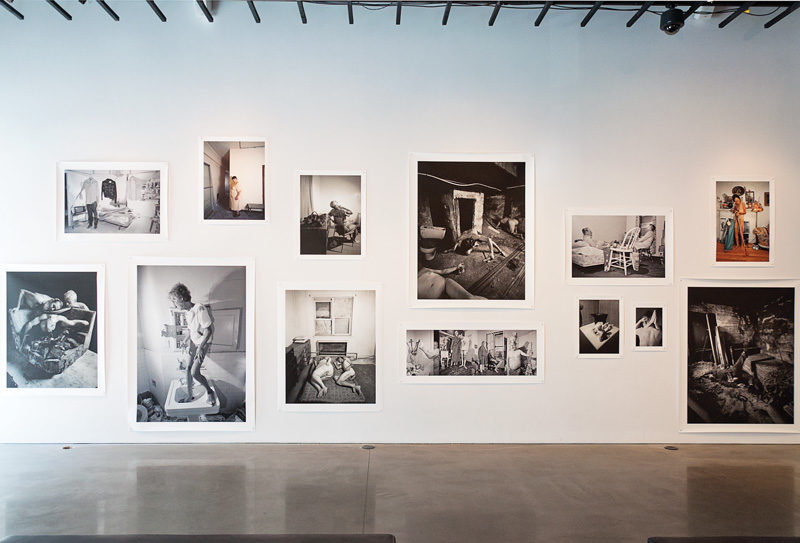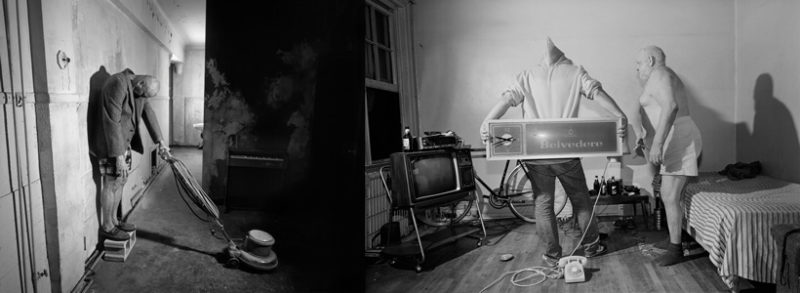[Fall 2012]
FOFA Gallery, Concordia University, Montreal
19 March to 20 April 2012
Curated by Erin Silver, this bilingually (and cleverly) titled exhibition juxtaposed works by Matthieu Brouillard and Donigan Cumming, two artists who, although they are separated by a generation and consequently possess different measures of experience, are both well known to the Montreal art scene. The act of juxtaposition is, in itself, a strong curatorial statement, and in this case it is especially worth drawing out its effects and implications. Placing works side by side in order to compare and contrast them is a standard art-historical strategy – the ultimate paradigm is the double projection in the art-history classroom, a method still used despite the changeover from analogue to digital slides. Within the context of exhibitions, it functions in much the same way: viewers are invited to assess two bodies of work against each other, to see where and how they intersect or diverge. The driving force behind this strategy is the idea that viewers’ understanding of each corpus will be greater after such a meeting has taken place.
In “Coming through the Fog”, however, the nature of the juxtaposition went far beyond the mere positioning of works alongside one another. Brouillard’s and Cumming’s photographs are overwhelmingly similar on many levels, a fact that was reinforced by several astute curatorial techniques. The works, which were all printed in various large formats on identical paper affixed directly to the walls with magnets, were conflated in salon-style clusters. Rather than being identified with individual labels, a schema supplied by the gallery and left on the bench in the middle of the space was the only key to determining each artist’s contribution. The most obvious attempt at blurring the line between Brouillard’s and Cumming’s practices was the audacious joining, in two separate instances, of their images on a single print. The overriding impression created by the exhibition, enhanced by the actual photographs selected, was thus one of sameness. Sitting on said bench at the centre of the gallery, I felt enveloped – this was a “one-room-show,” almost installation-like in its embrace – by a mass of bodies, many of which were entirely or partly naked, and most of which were not, as has been said, ugly or grotesque, but rather tragically and painfully ordinary. Coming through the Fog was an opportunity to revisit fragments from Cumming’s long-term photographic projects, from the 1980s and 1990s, based on intimate relationships with his subjects (who are represented primarily in the privacy of their own homes), and from Brouillard’s series produced since the early 2000s, which place nameless bodies in empty or industrial spaces and imbue them with heroic or mythological attributes.
Yet, once this overriding sameness was acknowledged and conceded to, the differences between their works were given a chance to emerge. The greatest distinction revolves around the idea of control – the control that each photographer apparently has over his respective subjects and scenes. Speaking in filmic terms, Brouillard can be seen as an Alfred Hitchcock type: a director who meticulously storyboards his scenes before their execution. Brouillard’s images are beautifully lit and his subjects carefully positioned; he knows drama and isn’t afraid to use it. Cumming, conversely, can be likened to a Werner Herzog (in his guise as a documentarian): a director who deftly coaxes out the idiosyncrasies of his subjects as the scene unfolds. There is a strong element of disarray in Cumming’s photographs – a sense that reality unbridled is being captured.
Yet (again), just as Herzog’s presence behind the camera is undeniable, so is Cumming’s, or it assuredly is when his works are seen through Brouillard’s fog. For that is the effect of the juxtaposition of these two practices, in the end: the ostensible methodological distinction between them is put into doubt. For Cumming, rubbing shoulders with Brouillard brings out the potential theatrics involved in the making of his photographs and emphasizes the directorial or participative role played by the photographer. For Brouillard, the encounter leads one to consider the significance of his own relationships with his subjects, who take on a less generic, humanity-as-such character. One is suddenly and forcefully confronted not with bodies, but with people. It is worth asking whether, once this melding of works has taken place, Brouillard’s and Cumming’s separate practices will ever be looked at in the same way, especially since the exhibition has been memorialized by a catalogue, co-produced by the fofa Gallery and Centre sagamie, that includes essays by Erin Silver and Eduardo Ralickas, as well as a joint statement by the artists. I would venture that this is precisely what Brouillard and Cumming had in mind.
Zoë Tousignant is a Ph.D. student in art history at Concordia University. She holds a master’s degree in museum studies from the University of Leeds, U.K. Her doctoral research concerns photographic modernism in Canadian illustrated magazines between 1925 and 1945.


